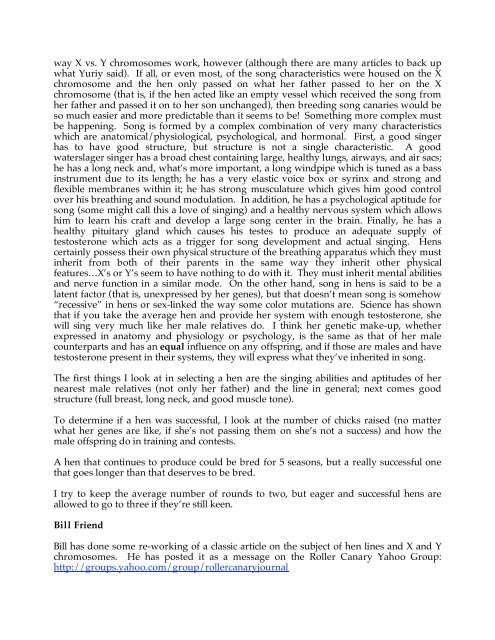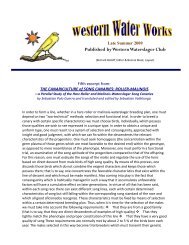Newsletter 1-06.pdf - Western Waterslager Club
Newsletter 1-06.pdf - Western Waterslager Club
Newsletter 1-06.pdf - Western Waterslager Club
You also want an ePaper? Increase the reach of your titles
YUMPU automatically turns print PDFs into web optimized ePapers that Google loves.
way X vs. Y chromosomes work, however (although there are many articles to back upwhat Yuriy said). If all, or even most, of the song characteristics were housed on the Xchromosome and the hen only passed on what her father passed to her on the Xchromosome (that is, if the hen acted like an empty vessel which received the song fromher father and passed it on to her son unchanged), then breeding song canaries would beso much easier and more predictable than it seems to be! Something more complex mustbe happening. Song is formed by a complex combination of very many characteristicswhich are anatomical/physiological, psychological, and hormonal. First, a good singerhas to have good structure, but structure is not a single characteristic. A goodwaterslager singer has a broad chest containing large, healthy lungs, airways, and air sacs;he has a long neck and, what’s more important, a long windpipe which is tuned as a bassinstrument due to its length; he has a very elastic voice box or syrinx and strong andflexible membranes within it; he has strong musculature which gives him good controlover his breathing and sound modulation. In addition, he has a psychological aptitude forsong (some might call this a love of singing) and a healthy nervous system which allowshim to learn his craft and develop a large song center in the brain. Finally, he has ahealthy pituitary gland which causes his testes to produce an adequate supply oftestosterone which acts as a trigger for song development and actual singing. Henscertainly possess their own physical structure of the breathing apparatus which they mustinherit from both of their parents in the same way they inherit other physicalfeatures…X’s or Y’s seem to have nothing to do with it. They must inherit mental abilitiesand nerve function in a similar mode. On the other hand, song in hens is said to be alatent factor (that is, unexpressed by her genes), but that doesn’t mean song is somehow“recessive” in hens or sex-linked the way some color mutations are. Science has shownthat if you take the average hen and provide her system with enough testosterone, shewill sing very much like her male relatives do. I think her genetic make-up, whetherexpressed in anatomy and physiology or psychology, is the same as that of her malecounterparts and has an equal influence on any offspring, and if those are males and havetestosterone present in their systems, they will express what they’ve inherited in song.The first things I look at in selecting a hen are the singing abilities and aptitudes of hernearest male relatives (not only her father) and the line in general; next comes goodstructure (full breast, long neck, and good muscle tone).To determine if a hen was successful, I look at the number of chicks raised (no matterwhat her genes are like, if she’s not passing them on she’s not a success) and how themale offspring do in training and contests.A hen that continues to produce could be bred for 5 seasons, but a really successful onethat goes longer than that deserves to be bred.I try to keep the average number of rounds to two, but eager and successful hens areallowed to go to three if they’re still keen.Bill FriendBill has done some re-working of a classic article on the subject of hen lines and X and Ychromosomes. He has posted it as a message on the Roller Canary Yahoo Group:http://groups.yahoo.com/group/rollercanaryjournal



